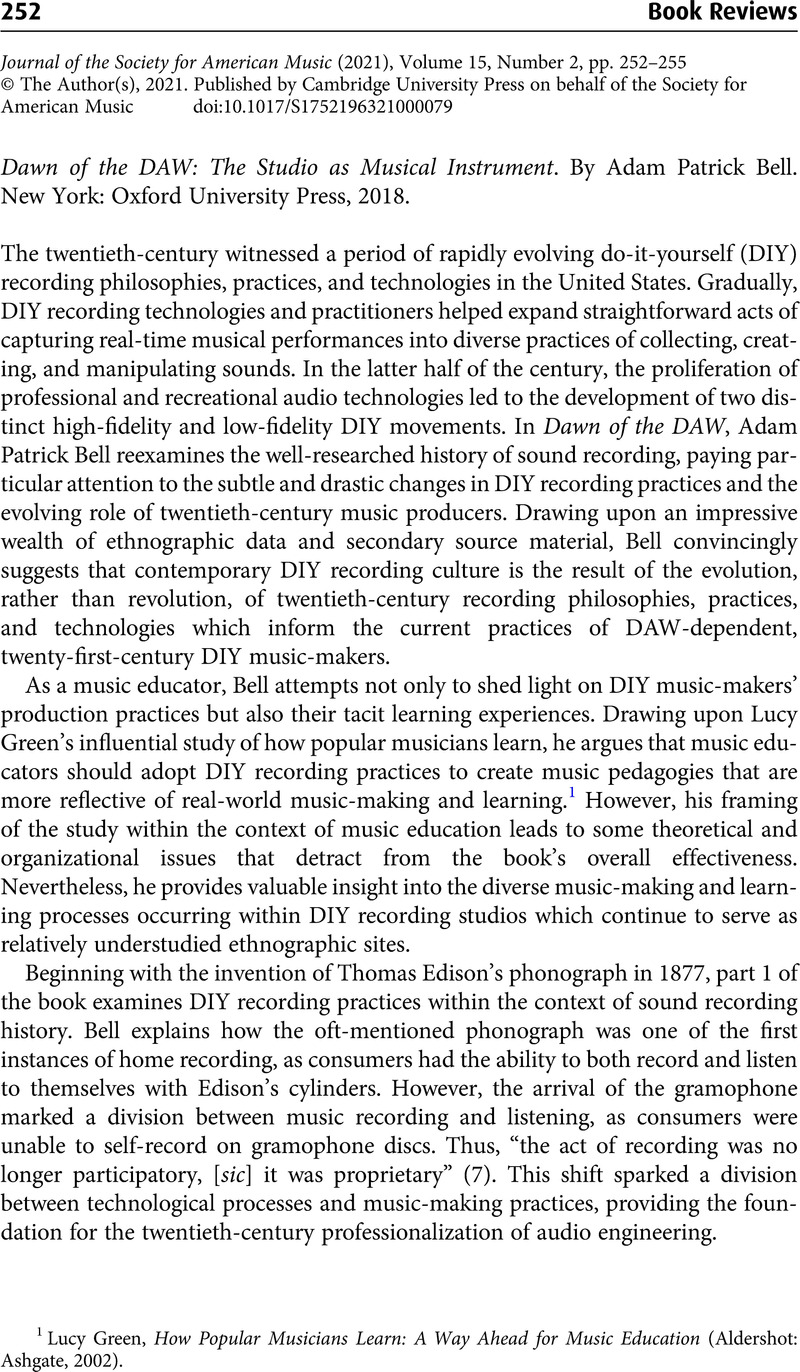No CrossRef data available.
Article contents
Dawn of the DAW: The Studio as Musical Instrument. By Adam Patrick Bell. New York: Oxford University Press, 2018.
Published online by Cambridge University Press: 04 May 2021
Abstract

- Type
- Book Review
- Information
- Copyright
- Copyright © The Author(s), 2021. Published by Cambridge University Press on behalf of the Society for American Music
References
1 Green, Lucy, How Popular Musicians Learn: A Way Ahead for Music Education (Aldershot: Ashgate, 2002)Google Scholar.
2 See Spencer, Amy, DIY: The Rise of Lo-fi Culture (London: Marion Boyars, 2008)Google Scholar and Dunn, Kevin, “‘If It Ain't Cheap, It Ain't Punk’: Walter Benjamin's Progressive Cultural Production and DIY Punk Record Labels,” Journal of Popular Music Studies 24, no. 2 (2012): 217–37CrossRefGoogle Scholar.
3 Some recent works centering on the intersections of DIY, race, gender, and sexuality include Attwood, Feona, “Sluts and Riot Grrrls: Female Identity and Sexual Agency,” Journal of Gender Studies 16, no. 3 (2007): 233–47CrossRefGoogle Scholar; Harrison, Anthony Kwame, Hip Hop Underground: The Integrity and Ethics of Racial Identification (Philadelphia, PA: Temple University Press, 2009)Google Scholar; and Griffin, Naomi, “Gendered Performance and Performing Gender in the DIY Punk and Hardcore Music Scene,” Journal of International Women's Studies 13, no. 2 (2012): 66–81Google Scholar.
4 Zagorski-Thomas, Simon, The Musicology of Record Production (Cambridge: Cambridge University Press, 2014)CrossRefGoogle Scholar.
5 Katz, Mark, Capturing Sound: How Technology Has Changed Music (Berkeley: University of California Press, 2004)Google Scholar; Evens, Aden, Sound Ideas: Music, Machines, and Experience (Minneapolis: University of Minnesota Press, 2005)Google Scholar; Théberge, Paul, Any Sound You Can Imagine: Making Music/Consuming Technology (Hanover, NH: Wesleyan University Press, 2007)Google Scholar; and Zak, Albin, I Don't Sound Like Nobody: Remaking Music in 1950s America (Ann Arbor: University of Michigan Press, 2010)CrossRefGoogle Scholar.
6 Green, Lucy, Music, Informal Learning, and the School: A New Classroom Pedagogy (Burlington, VT: Ashgate, 2008)Google Scholar; and Folkestad, Göran, Hargreaves, David J., and Lindström, Berner, “Compositional Strategies in Computer-Based Music-Making,” British Journal of Music Education 15, no. 1 (1998): 83–87CrossRefGoogle Scholar.
7 See Bell, Adam Patrick, “Trial-By-Fire: A Case Study of the Musician-Engineer Hybrid Role in the Home Studio,” Journal of Music, Technology, and Education 7, no. 3 (2014): 295–312CrossRefGoogle Scholar; and “DIY Recreational Recording as Music Making,” The Oxford Handbook of Music Making and Leisure, ed. Roger Mantie and Gareth Dylan Smith (New York: Oxford University Press, 2017): 81–91.




